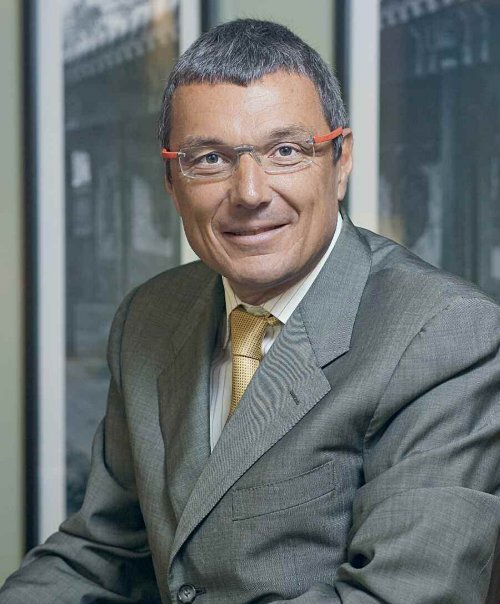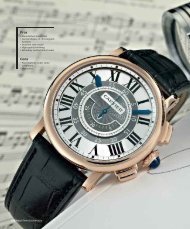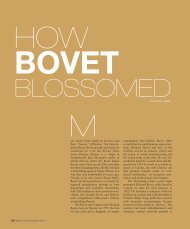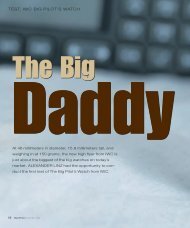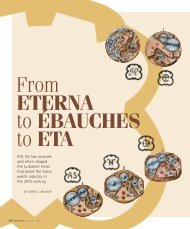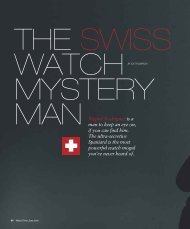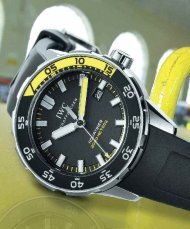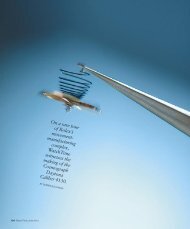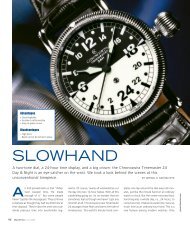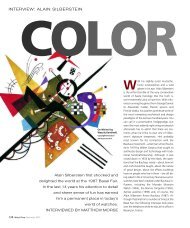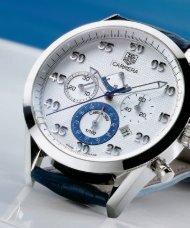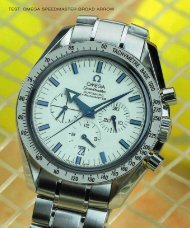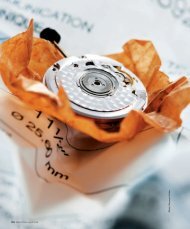interview jean-christophe babin - Watchtime.net
interview jean-christophe babin - Watchtime.net
interview jean-christophe babin - Watchtime.net
You also want an ePaper? Increase the reach of your titles
YUMPU automatically turns print PDFs into web optimized ePapers that Google loves.
NEWSMAKERTAG Heuer CEO Jean-Christophe Babin discussesthe new Pendulum concept watch, why the MonacoV4 took so long, and Seiko’s controversialcontribution to TAG’s new Calibre 1887.TAGHeuer has had a busy 2010. This yearit celebrated its 150th anniversary. Itbrought to market the Monaco V4 watchafter six years developing its movement’srevolutionary drive belts. At Baselworld, itlaunched a new concept watch, the Pendulum,which uses four mag<strong>net</strong>s instead of atraditional hairspring to provide torque tomake the balance wheel oscillate. And itbegan production of its first in-housechronograph movement, Calibre 1887,amidst a storm of controversy over TAG’suse of a Seiko Instruments Inc. design. RecentlyTAG Heuer CEO Jean-ChristopheBabin discussed all of these topics withWatchTime contributor Rüdiger Bucher,editor-in-chief of WatchTime’s Germanbasedsister publication, Chronos.WT: You presented the Monaco V4 in2004, but it didn’t go on sale until 2010.How long do you expect it will take forthe Pendulum to become available?JCB: We’re already farther along with thePendulum than we were with the V4 in2004. Then, we had only one prototype —and that one just barely ran properly. Itsheartbeat was good, but we still had unsolvedproblems with a few of its drivebelts. In 2005, when we decided to takeconcrete steps toward launching the V4,we more or less had to start all over again.The main problem was the drive belts: wehad to determine the best material and calculatethe best form so that these componentscould play their part in the horologicalpower train. It took us five more yearsDecember 2010 WatchTime 69
INTERVIEWJean-Christophe Babinbefore we were absolutely sure that thequality and precision were just right. We’refarther along with the Pendulum.WT: How many Pendulums have youbuilt so far?JCB: Six.WT: How good are the rate results?JCB: That depends. Some days we’re veryclose to values that could meet theCOSC’s standards for certifiedchronometers. But changes in ambienttemperature are problematic for the mag<strong>net</strong>balance and can cause the watch torun a few minutes too fast or too slow.We knew from the start that the metal alloyscommonly used for mag<strong>net</strong>s are sensitiveto temperature changes and thatthis sensitivity would adversely affect therate of the watch. It’s not possible yet tointroduce this watch on the market withthe material that we’ve been using so far,but we decided to continue working withthis technology anyway. All the othertechnical aspects are promising: for example,the insensitivity to shocks andblows. And the temperature problem isclearly defined, so we’re confident thatwe’ll be able to find a solution.The solution, which we’re working onwith physicists and technicians, could lieeither in innovative alloys or in a kind oftemperature compensation for the givenalloy. The latter could be done by addingan additional metal to the existing alloy.In any event, as a watch manufacturerwe’re venturing into a new field, wherewe need to collaborate closely with scientists.This involves basic research. Andthat means you don’t know when you’llfind the solution. It could take sixmonths, but it could also take six years.The Pendulumconcept watchhas a mag<strong>net</strong>propelledbalance (below).WT: The V4 calls into question the conceptof power transmission via gears. ThePendulum proposes a radical rethinkingof the rate regulator. Did TAG Heuer intendto challenge traditional watchmakingmethods?JCB: As far as the Pendulum goes, we believethat balance springs will continue toplay an essential role in the future. But atthe same time, we want to prove that othermethods of regulation are feasible —70 WatchTime December 2010
INTERVIEWJean-Christophe BabinThe Monaco V4, frontand back (below)not to replace conventional regulators,but to augment them. It was the samewith the V4. The drive belts weren’t intendedto replace traditional watchmakingwith wheels and pinions, but to supplementthem. It’s an opportunity for usto show what’s possible in the field ofhaute horlogerie. But this technology isn’tmeant for producing large numbers ofwatches. That’s why we manufacturedonly 150 of the Monaco V4.The third theme that we’re workingon right now is the power source, that is,the barrel and the mainspring. But wedon’t intend someday to make watcheswithout balance springs, without wheelsto transfer the power, without jewels, andwith a new type of power transmission.Instead, if and when the situation arises,we want to be able to use drive belts or amag<strong>net</strong> balance. We want to show thatthere are alternatives. We want to masterthese alternatives and put them — at leastpartly — into “ordinary” watches.WT: Do you have an example?JCB: Why shouldn’t there be a chronographmovement that also uses drive beltsin addition to traditional wheels and thatrelies on ball bearings instead of conventionaljewels? Perhaps we could put thoseideas into practice in our 1/100-secondchronograph? At such high speeds, beltscould play a more effective role thanwheels. This doesn’t mean that there wouldbe nothing but belts throughout the entire“WE’RE ALREADYFARTHER ALONGWITH THEPENDULUM THANWE WERE WITHTHE V4 IN 2004.”movement. Perhaps we could use them onlyfor the chronograph mechanism.The situation with the mag<strong>net</strong>s is similar.Maybe we could install them elsewherein the movement as well, not solelyin the balance. After all, a mag<strong>net</strong>ic field isa kind of energy source. The intensity ofthe mag<strong>net</strong>ic field is also a critical factor.Our balance oscillates at a pace of 43,200semi-oscillations per hour. With strongermag<strong>net</strong>s, we could increase the speed tenfold.Perhaps such powerful mag<strong>net</strong>scould also be used as a power source.WT: So you’re exploring new ground betweenwatchmaking and science.JCB: Exactly. We could never have builtthe V4 if we had relied solely on the art ofclassical watchmaking. Collaborationamong mathematicians, physicists andwatchmakers was crucial. For example,consider the drive belts with their minusculeteeth. To accomplish something likethat, you simply must work with otherbranches of industry — and with mathematiciansto calculate the elasticity, thelength and the thickness of the belts.Watchmakers don’t come into the pictureuntil it’s time to insert the belts into themovement.The challenge for our Pendulum wasto use four little mag<strong>net</strong>s to generate astable mag<strong>net</strong>ic field that would be capableof subdividing the incoming energy sothat the balance would oscillate at the desiredfrequency. That’s six Hertz or43,200 semi-oscillations per hour now,but it could also be 36,000 or 72,000 orperhaps even 360,000. You’ve got to calculatethat; you can’t try it out empirically.For the V4, we had to master the materialthat the toothed belts are made of.It had to be made useable in the contextof watchmaking. When belts of this kindare used in micro-medical applications —for example, in a drill — a speed differenceof, say, five percent is insignificant.But that would have fatal consequencesfor the precision of a wristwatch.WT: Who conceived the idea of usingmag<strong>net</strong>s for a watch’s balance?JCB: Thomas Houlon, who is in our marketingdivision. He was wondering if therewas a way to take mag<strong>net</strong>ism, which is es-
INTERVIEWJean-Christophe BabinTAG Heuer’sCalibre 1887watch andan explodedview of itsmovement(above)“OUR MOVEMENTDIFFERS FROMSEIKO’S IN IMPOR-TANT DETAILSLIKE DIAMETER,HEIGHT, BRIDGESAND BASE PLATE.”sentially deleterious for a mechanicalwatch, and put it to positive use in a movement.One Monday morning four yearsago, he came to work with a woodenmodel he’d built. He had put mag<strong>net</strong>s on abalance that oscillated back and forth betweentwo additional mag<strong>net</strong>s mountedon the sides of the model. That was hisoriginal idea, which we then passed alongto the people in our research-anddevelopmentdepartment. The mag<strong>net</strong>sare now no longer on the balance’s hoop,as they were on Houlon’s model, but havebeen relocated onto its staff. Then we hadto determine how large, how powerfuland how far apart from one another themag<strong>net</strong>s would need to be.WT: You introduced the V4 conceptwatch in 2004, but soon realized that youwouldn’t be able to produce it as planned.That must have given you a few sleeplessnights, especially since many doubtedwhether the watch would ever be sold.How did you begin finding a solution?JCB: There were no prior experiences inwatchmaking that we could rely on. Wehad to consult mathematicians and physicists.It became clear that we would need toput teeth on the drive belts, so we startedlooking for suitable suppliers. At the sametime, we needed the belts and their teeth tobe much smaller than the ones used inmedical technology. The elasticity of thematerial was critical too. If it’s not sufficientlyelastic, the belts jam; but if it’s tooelastic, the precision suffers. Ultimately, wefound a solution that relies on a metal beltsurrounded by a polymer and on teeth cutinto the belt with a cold laser. Those twobelts are positioned on the back side of thewatch. The belts on the front have no metalinlay and consist solely of the polymer.We gained many new experiences inthe course of this process. In watchmaking,trial and error is the method ordinarilyused for developmental work: youmake various prototypes, you changevarious details, and you gradually comecloser and closer to the ideal situation.But that’s not the approach we took forthe V4 and the Pendulum. We calculatedeverything, just as aircraft engineers do,because they’ve got to be certain thateverything is exactly right before the newmodel makes its maiden flight.WT: It’s costly to develop watches like theV4 and the Pendulum. How will youmake these investments pay off?JCB: I believe that at some time or other,every great brand must devote its effortsto projects whose ultimate results are notentirely predictable. A small businesscan’t afford to do that. But a big operationlike TAG Heuer, which ranks among theworld’s largest manufacturers of luxurywatches, must also be active in areas outsideits core competency and must dare tomake investments that don’t promise togenerate immediate profits. In the worstcase, doing this improves your knowhow.But in the best case, you blaze newtrails for industrial manufacturing. That’sthe advantage of size: you can offer yourshareholders the likelihood of profits, youcan provide commercial products for alarge clientele, and you can explore newdimensions in R&D. We’re not obligatedto solve the temperature problem withinsix months’ time. We’re not under timepressure. Our company gains new experiencesby working on this project and bycollaborating with external experts.That’s very valuable and stimulating. Unlikea traditional factory, we aren’t underquite so much pressure from the sales division,which always wants finished productsthat can be delivered as quickly aspossible. We continue to earn our moneywith large-series models like Aquaracer,Carrera and Grand Carrera.74 WatchTime December 2010
WT: You introduced your new chronographCalibre 1887 in December 2009.The movement quickly sparked discussionsamong connoisseurs when it becameapparent that the base caliber camefrom Seiko, a fact that you hadn’t madeclear right from the start. Could you clarifythis issue now: exactly which parts ofthis caliber do you make yourself andwhich parts come from Seiko?JCB: Seiko sold us the rights to the intellectualproperty. The background is asfollows: Seiko applied for patents for aproject in the late 1990s; based on thesepatents, Seiko Instruments, which is partof the Seiko Group, developed a genuinemanufacture movement, which it producedin very small numbers in Japan.Seiko sold a few watches with this caliberaround the year 2000 solely in Japan.When we began looking for optionsfor constructing our own chronograph,we had to orient ourselves according tovarious specifications. Our movementwould have to be an integrated chronographcaliber with a column wheel, butnot like Zenith’s El Primero and not witha pace of 36,000 semi-oscillations perhour. It would have to differ from thechronograph movements that we’d alreadyused and we also wanted it to be“WE WANT TOPROVE THAT OTHERMETHODS OFREGULATION AREFEASIBLE; NOTTO REPLACECONVENTIONALONES, BUT TOAUGMENT THEM.”slimmer than the Valjoux 7750. Thesespecs resulted in technical requirementsthat were very similar to the ones describedin Seiko’s patent documents. Soinstead of starting from square one andreinventing the wheel, we contacted Seikoand asked them if we could purchase certainelements of the intellectual propertyrights to this caliber. That would enable usto save two or three years’ time. The performanceof the watches that Seiko hadmanufactured for the Japanese marketwas very good and the construction wasexactly what we needed.Nevertheless, after we’d reached anagreement with Seiko, we still had to industrializeeverything anew. There’s a bigdifference between making a few thousandunits via manufacture work as Seikohad done in Japan on the one hand, andour plans on the other hand, which envisionedproducing tens of thousands ofcalibers per year. So starting with thepatent, we proceeded, as it were, from ablank page, organizing the entire constructionaccording to our planned production.As a result, our movement differsfrom Seiko’s caliber in many importantdetails, for example, the diameter,the height, the base plate and the bridges.And unlike Seiko’s escapement, ours is76 WatchTime December 2010
INTERVIEWJean-Christophe Babinsupplied by Nivarox. The two calibers alsodiffer with regard to the productionprocess and the machinery. So, althoughour caliber is constructively based on thesame ideas as Seiko’s, it’s nevertheless agenuine TAG Heuer caliber. And needlessto say, it’s “Swiss made.”WT: Which components do you makeand which parts does Seiko deliver?JCB: Among other parts, we produce thebase plate, the bridges and the inner portionof the rotor. In addition to that, wealso collaborate with 22 suppliers. Oneof them is Seiko Instruments, fromwhich we order some of the stampedparts. The other 21 suppliers are allSwiss, for example Kif for the shock absorbersand Nivarox for the escapement.Fleury, one of Switzerland’s best manufacturers,produces the machines that weuse for our own production. They deliverto us the machines for dry-millingbrass components such as plates andbridges. By eliminating the use of oil, wedon’t need to cleanse the parts betweentwo sequential processing steps: thatsaves time and money, which is an importantfactor for big-series productionlike ours.WT: How many Calibre 1887 watcheswill you make in 2011?JCB: Next year, I expect, we’ll make30,000 movements. Over the midterm, weplan to boost that figure to 50,000.WT: What percentage of your movementsdo you still order from ETA and whichcompanies are your other suppliers?JCB: We currently order only slightly morethan 50 percent of our movements fromETA. That figure was 99 percent a fewyears ago. When [the late Swatch Groupchairman, Nicolas G.] Hayek announced afew years back that he planned to reducedeliveries of ETA movements to otherbrands, we had to look for other potentialsuppliers. One of them is Zenith: Caliber36, which is based on El Primero, sells well,above all in this price class. And from thestart, we strongly supported Sellita’s projectof developing its own movements. Wealso resumed collaboration with DuboisDépraz, with which Heuer and Büren had“AT PRESENT, WE’REPROBABLY THECOMPANY WITHTHE WIDEST BASEOF MOVEMENTSUPPLIERS.”ManufacturingCalibre 1887 inLa Chaux-de-Fondsdeveloped the automatic chronograph Caliber11 in 1969. Today, all Monacochronographs run with Dubois Déprazmodules. Soprod delivers the movementfor our Grand Carrera GMT. And we’restarting with our own Calibre 1887. Atpresent, we’re the company with probablythe widest base of movement suppliers.This ensures that we’ll be able to meet ourproduction quotas and to grow, and it alsogives us a broad diversity of movements.Incidentally, the situation is similar withour quartz movements. In the past, we hadordered them exclusively from ETA; nowwe also buy them from Ronda. And withCaliber S, we have our own quartz caliber.WT: You’ve been at TAG Heuer’s helmfor nearly a decade. How would you describethe changes that have transpiredsince you took command?JCB: Many things had already changed inthe 1990s. TAG Heuer, which had stillbeen a small business in the 1980s, developedinto an important player in thewatch industry in the ’90s. The focus atthat time was on sport watches, primarilywith quartz movements, and marketingplayed a decisive role. Then I soughtto expand the horological competence,especially in the field of mechanicalwatchmaking, because above a certainprice, customers simply insist on mechanicalmovements. It’s like the auto industry:starting at a particular price level, acustomer expects a six-cylinder engine.And in even higher price echelons, it hasto be an eight- or 12-cylinder engine.WT: TAG Heuer produced 750,000watches per year in the mid-1990s. Thetotal declined afterward because youmade more mechanical watches and theaverage price increased. Prior to the recession,the number of watches manufacturedhad risen again. How many watchesdoes TAG Heuer make each year?JCB: We don’t publish exact statistics,but I can say that our annual productionis between 500,000 and one million. It’snot so far from the totals we reached inthe 1990s. Of course, because of the crisis,last year’s figure was under 700,000.But in a good year, we come close toequaling our best performance.


